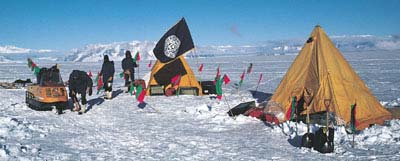 |
 |
| current issue |  |
past issues |  |
send a letter/news |  |
address update |  |
advertise |  |
about us |  |
alumni home |
Features
Science on IcePage 2 of 4
Mayewski calls Antarctica the "last canary." It is the one place on Earth that is still relatively untouched, so it makes an ideal laboratory for studying natural climate change. Information gathered there can help scientists to calculate the effects of man-made pollution on the climate and environment.
Populated primarily by scientists and governed by international treaty, Antarctica is owned by no one. This remotest spot on Earth has become a truly "free zone," a continent of cooperation. "One of the wonderful things about science," says Mayewski, "is that it's not concerned with international politics. When you're studying atmospheric and ocean circulation, borders are meaningless. And if you're trying to solve global problems, you have to think globally and work with others."
Which is the whole philosophy behind ITASE. For the past decade, Mayewski, director of the international project, has helped other countries launch a series of field projects in Antarctica, even as he has been busy orchestrating and leading a dozen or so research trips to other corners of the Earth—to the Himalayas, the Arctic and Greenland. Planning for the U.S. ITASE expedition began about five years ago. And now, finally, at the tail end of the last year of the millennium, the U.S. team is headed out into the cold.From Freezer to Frozen Landscape

|
Joe Souney's trip to Antarctica actually began in a freezer many months before his arrival. Souney estimates he's spent at least 500 hours in UNH's Freezer No. 1, scraping and cutting ice cores. He has also collected snow samples on top of Mt. Washington, fighting to stand upright in 80 mph winds. But mostly he's worked in the relative comfort of a 4-degree Fahrenheit freezer. Dressed as if for surgery on the moon, he wears a hooded white suit over his puffy parka, heavy pants and mukluk boots as he prepares the ice samples for analysis.
Students chosen for a polar expedition need to prove themselves, according to Mayewski, who has worked with more than 200 assistants. "If they come out of the freezer, or off the summit of Mt. Washington, and they're still smiling, they're a candidate," he says. "Students don't have to go on an expedition to get a degree, but at UNH we have a tradition of making this a real possibility."
Souney has passed not only the "Mayewski test," but the stringent medical and dental exam required by the National Science Foundation. When he arrives in Antarctica in late October, his training continues at McMurdo Station, an old military base on the edge of the Ross Ice Shelf in West Antarctica. With its summer population of about 1,200, McMurdo Station hardly feels like a remote wilderness. Its nearly 100 buildings include a carpentry shop, a mechanic shop, a large laboratory, a desalinization plant and a cafeteria. "It's like a small town," says Souney. "But you're surrounded by these huge mountain ranges, covered in snow and glaciers—and most of them have never been climbed."
During Snowcraft I, the required two-day course for all new arrivals, Souney is part of a team struggling in whiteout conditions to set up three tents, canvas teepees tall enough for a man to stand in. The training site on the frozen sea ice of McMurdo Sound is only a few miles from the base, but the weather is fierce. "The wind is so loud we had to stand next to each other and yell," says Souney. They also build a 25-foot-long, four-foot-high snow wall and pitch several smaller two-man tents. They learn the danger of thawing frostbitten limbs too soon and how to work the small gas stoves in their emergency survival kits. During his first night out, Souney forgets to leave his tent door cracked open. His breath condenses on the inside walls. Every time he moves, jostling the sides of the tent, it snows down on top of him. By morning, the outside of his sleeping bag is damp and cold.
Souney and the ITASE team spend another day learning how to save each other's lives should one of them plunge into a crevasse. Kevin Pusey, the ITASE safety officer, is a climbing guide who specializes in cold region expeditions. He knows that snow and ice are serious business. He remembers vividly the time his climbing companion disappeared in front of him, the sickening slackness of the rope, the jerk that pulled him to the ground, dragging him toward the edge of the crevasse. He remembers slamming his boots against the snow, fighting his increasing speed, fumbling for his ice pick, driving it again and again into the snow, trying to stop the drag. He had 30 feet to save himself—to save them both. He managed, but it was nothing he ever wants to go through again.
Pusey's job is to make sure every expedition member knows the routine: how to grab the ice pick and anchor the dangling victim. How to set up a three-to-one "Z" pulley system and how, with the greatest of care, to haul the person to safety. Though he's prepared, Pusey isn't expecting any mishaps. He understands glaciers, recognizes the telltale cracks, the shifting snow patterns that might suggest a hidden crevasse. And he has a radar unit to help him identify weak areas that might give way under the weight of a man or snowmobile.
Page: < Prev 1 2 3 4 Next >Easy to print version

